Potřebujeme váš souhlas k využití jednotlivých dat, aby se vám mimo jiné mohly ukazovat informace týkající se vašich zájmů. Souhlas udělíte kliknutím na tlačítko „OK“.
ASTM F2605-08e1
Standard Test Method for Determining the Molar Mass of Sodium Alginate by Size Exclusion Chromatography with Multi-angle Light Scattering Detection (SEC-MALS) (Includes all amendments And changes 6/27/2016).
Automaticky přeložený název:
Standardní zkušební metoda pro stanovení molární hmotnost alginát sodný vylučovací chromatografií s Multi-úhel rozptylu světla Detekce (SEC-Mals)
NORMA vydána dne 1.2.2008
Informace o normě:
Označení normy: ASTM F2605-08e1
Poznámka: NEPLATNÁ
Datum vydání normy: 1.2.2008
Kód zboží: NS-54223
Počet stran: 6
Přibližná hmotnost: 18 g (0.04 liber)
Země: Americká technická norma
Kategorie: Technické normy ASTM
Kategorie - podobné normy:
Anotace textu normy ASTM F2605-08e1 :
Keywords:
Alginates, Size exclusion chromatography with multi-angle light scattering detection (SEC-MALS), Tissue engineered medical products (TEMPs), ICS Number Code 11.120.10 (Medicaments)
Doplňující informace
| Significance and Use | ||||||||||
|
The composition and sequential structure of alginate, as well as the molar mass and molar mass distribution, determines the functionality of alginate in an application. For instance, the gelling properties of an alginate are highly dependent upon the composition and molar mass of the polymer. Light scattering is one of very few methods available for the determination of absolute molar mass and structure, and it is applicable over the broadest range of molar masses of any method. Combining light scattering detection with size exclusion chromatography (SEC), which sorts molecules according to size, gives the ability to analyze polydisperse samples, as well as obtaining information on branching and molecular conformation. This means that both the number-average and mass-average values for molar mass and size may be obtained for most samples. Furthermore, one has the ability to calculate the distributions of the molar masses and sizes. Multi-angle laser light scattering (MALS) is a technique where measurements are made simultaneously over a range of different angles. MALS detection can be used to obtain information on molecular size, since this parameter is determined by the angular variation of the scattered light. Molar mass may in principle be determined by detecting scattered light at a single low angle (LALLS). However, advantages with MALS as compared to LALLS are: (1) less noise at larger angles, (2) the precision of measurements are greatly improved by detecting at several angles, and (3) the ability to detect angular variation allows determination of size, branching, aggregation, and molecular conformation. Size exclusion chromatography uses columns, which are typically packed with polymer particles containing a network of uniform pores into which solute and solvent molecules can diffuse. While in the pores, molecules are effectively trapped and removed from the flow of the mobile phase. The average residence time in the pores depends upon the size of the solute molecules. Molecules that are larger than the average pore size of the packing are excluded and experience virtually no retention; these are eluted first, in the void volume of the column. Molecules, which may penetrate the pores will have a larger volume available for diffusion, they will suffer retention depending on their molecular size, with the smaller molecules eluting last. For polyelectrolytes, dialysis against the elution buffer has been suggested, in order to eliminate Donnan-type artifacts in the molar mass determination by light scattering (1, 2). However, in the present method, the size exclusion chromatography step preceding the light scatter detection is an efficient substitute for a dialysis step. The sample is separated on SEC columns with large excess of elution buffer for 30 to 40 min, and it is therefore in full equilibrium with the elution buffer when it reaches the MALS detector. |
||||||||||
| 1. Scope | ||||||||||
|
1.1 This test method covers the determination of the molar mass of sodium alginate intended for use in biomedical and pharmaceutical applications as well as in tissue engineered medical products (TEMPs) by size exclusion chromatography with multi-angle laser light scattering detection (SEC-MALS). A guide for the characterization of alginate has been published as Guide F 2064. 1.2 Alginate used in TEMPs should be well characterized, including the molar mass and polydispersity (molar mass distribution) in order to ensure uniformity and correct functionality in the final product. This test method will assist end users in choosing the correct alginate for their particular application. Alginate may have utility as a scaffold or matrix material for TEMPs, in cell and tissue encapsulation applications, and in drug delivery formulations. 1.3 This standard does not purport to address all of the safety concerns, if any, associated with its use. It is the responsibility of the user of this standard to establish appropriate safety and health practices and determine the applicability of regulatory limitations prior to use. |
||||||||||
| 2. Referenced Documents | ||||||||||
|
Podobné normy:
Historická
1.4.2014
Historická
15.12.2010
Historická
15.5.2009
Historická
1.8.2010
Historická
1.6.2011
Historická
1.8.2013


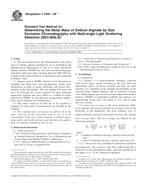
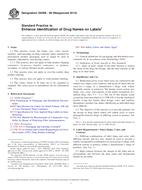 ASTM D6398-08(2014)..
ASTM D6398-08(2014)..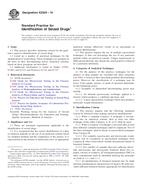 ASTM E2329-10
ASTM E2329-10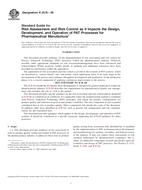 ASTM E2476-09
ASTM E2476-09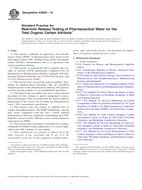 ASTM E2656-10
ASTM E2656-10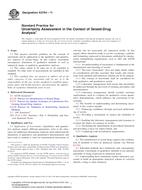 ASTM E2764-11
ASTM E2764-11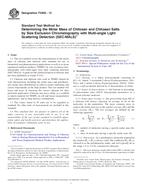 ASTM F2602-13
ASTM F2602-13
 Cookies
Cookies
